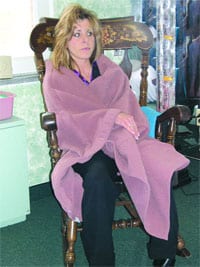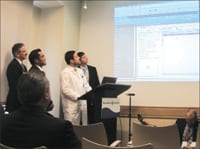A Sensory Approach Cooley Dickinson Reduces Need for Restraints in Psychiatric Patients
The image of patients in psychiatric wards being held down against their will isn’t one that behavioral health professionals want to promote — even though such physical restraints are indeed sometimes needed to control patients.
Certainly, they aren’t the ideal method, said Tina Champagne, an occupational therapist with Cooley Dickinson Hospital, who has put the Northampton facility at the forefront of a movement to reduce the use of restraints with a gentler, sensory approach — one that allows patients to make choices in the way they modify their behavior.
CDH’s sensory room is part of this approach. The room features many types of seating options, music, lighting, posters, and other items and activities that stimulate the senses in different ways, allowing patients to regulate their own behavior.
“In some hospitals, most of the environment is institutional,” Champagne said. “We’re trying to develop a space that’s a little more normal and home-like, something that can be replicated for people when they leave.”
The sensory room “is a place where people can engage in relaxation activities, even journaling. There are self-help books, aromatherapy, rocking chairs, videos, things like that. The space is designed and organized in a way that’s conducive to those activities.”
The goal, Champagne said, is to help patients “self-regulate” — a term that can encompass many goals.
“If they need to calm down, we take out things that the patient tells us are relaxing to them,” she said. “If they’re depressed, they might not want to relax, but be more uplifted or alerted. If they need to be more uplifted, we ask them what things uplift them. If they want to try something new, the unit is a safe place to explore new coping options.
“They’re actively engaged in the process,” she added. “So it’s not merely diagnosis-specific; there’s something for everybody. It’s just a matter of learning what their specific needs, tendencies, and preferences are.”
Champagne said the behavioral health staff at Cooley Dickinson conducted a pair of quality-improvement studies after introducing the sensory room in 2003. “Basically,” she said, “each demonstrated that the majority of the patients found it to be very beneficial to use.”
Blanket Approach
In creating such a place for patients, CDH was following the lead of the Mass. Department of Mental Health, which has called for a reduction in the use of restraints, particularly among children and adolescents. Champagne said sensory methods have worked just as well with adults.
A second example is CDH’s use of weighted blankets, yet another way behavioral health patients can self-regulate their behavior and feelings.
“We were looking for more tools to reduce the use of restraint and seclusion, and to help people self-nurture and feel better,” Champagne said. The weighted blankets, which are adjustable from five to 30 pounds, are one way the staff has done just that.
“There’s something about the pressure that people find to be comforting and calming, and helps them self-organize,” she explained. “They’re relatively safe to use, even when people are in a real crisis state.”
Champagne noted that the blankets had been trialed successfully with children in other parts of the state.
“We figured we’d try them with adults in our acute-care psychiatric unit,” she said. “They hadn’t been used in this particular setting in the past; it had been children with autism or pervasive developmental disabilities.”
Patients must be medically cleared to use the blankets, of which CDH now owns 14. For instance, people with respiratory problems or pregnant women might not be ideal matches for the therapy.
“But in general, we’ve found this to be very helpful,” Champagne said. “We’ve had people who had gone into restraints before but no longer are because of the blankets. They like that the blankets are like a regular comforter, and that they’re not forced on them.” They also help some patients fall asleep more easily, she added.
Cooley Dickinson has been studying the effects of the weighted blankets in collaboration with the UMass School of Mechanical Engineering and Creighton University.
In fact, Champagne will head to St. Louis in the spring, along with Debra Dickson, a clinical nurse specialist at CDH; and Brian Mullen, an engineering researcher from UMass, to present their weighted blanket studies at the annual conference of the American Occupational Therapy Association. In addition, their first study on the topic was recently accepted for publication in the Occupational Therapy in Mental Health Journal.
Vested Interest
Meanwhile, Champagne and her team are working with UMass students on introducing an inflatable deep-pressure vest that works much like the blanket, but can be used in a seated or standing position. Mullen helped to create the vest, which works through an air-bladder system connected to an electric pump. The wearer can adjust the pressure using a keypad.
“Research indicates that a weighted vest can be helpful for children with autism, or who have ADD and are trying to concentrate on schoolwork,” Champagne said. “The pressure in and of itself is very organizing for some people.”
She added that the hospital staff continues to look for more tools to help them reduce the use of restraints and seclusion and instead help patients feel safer, more secure, and, well, more like themselves again.
“The bottom line is that people have the power to change the way they feel,” she said. “So it’s very empowering. For us, it’s just a matter of offering enough choices.”




Comments are closed.